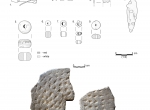The Kroczycka Cave
The Kroczycka Cave, commune Kroczyce, Zawiercie district – the site was discovered in 1936 during calcite extraction. The cave held the remains of forty individuals resting on the surface of the cave deposit around four hearths. Other findings included wheel-made pottery, fragments of storage vessels of a type known as Krausengefässe, a rotary quern and animal bone. The first survey of the cave and chronological determinations were made by Jan Fitzke of the Jagiellonian University with a group of students a few days after the discovery. The assemblage discovered inside the cave was assigned to the Late Roman Period and early stages of the →Migration Period. Unfortunately by the time the cave was investigated by qualified archaeologists, most of the bones and artefacts had been dug up and passed to the members of the local population. A comprehensive analysis of the pre-1939 findings was made in 1966 by R. Mycielska and E. Rook. They re-examined the cave materials in great detail and confirmed the chronology proposed by J. Fitzke.
Over the years, more accidental discoveries of archaeological material were made inside the cave. There were reports for example on human bones present in the rubble lining the cave bottom. In 1983 a surface find was made of a large assemblage of human and animal bones, pottery, a bronze brooch type A.158 and three beads. Bones of 17 individuals were identified, among them no less than nine belonging to small children (Infans I and Infans II). The animal bone assemblage included the remains of sheep/goats, birds and single bones of horse.
The first regular archaeological fieldwork was carried out in 1993-1994 on the terrace at the entrance to the cave. A sondage trench was excavated, revealing three levels of occupation: Late Palaeolithic, Hallstatt Period (Lusatian Culture), and →Przeworsk Culture from its late developmental phase (C3-D). The assemblage of finds recovered from the Przeworsk Culture horizon included fragments of pottery, both hand-built and wheel-made, a set of spindlewhorls, a glass bead and a fragment of a →tongued-shaped strap-end (group VI, type 12, variant 2 of R. Madyda-Legutko). The artefacts were dated to phases C3-D.
In 2014 another excavation was carried out at the entrance to the Kroczyce Cave supervised by Tomasz Wagner of Jagiellonian University Institute of Archaeology. The result of this project was the recovery of another assemblage of sherds of hand-built and wheel-made pottery, a further large series of spindlewhorls, an amber bead, and some disarticulated human bones. A small pit attributed to the Przeworsk Culture was recorded as well, and the presence at this location of occupation levels dated to the Late Palaeolithic, the Hallstatt Period and additionally, recorded for the first time, a late medieval horizon.
The function of the site is still unclear. In view of the character of the archaeological material, most notably of the unprecedented accumulation of human remains, the most commonly accepted interpretation is that of a refuge, used in a period of unrest experienced during the →Migration Period, alternately, a sacrifice site or a burial ground.
Tomasz Wagner
Literature: R. Mycielska, E. Rook, Materiały archeologiczne z Jaskini w Kroczycach, pow. Zawiercie, Materiały Archeologiczne, 7, 1966, p. 185-190; K. Cyrek, Podsumowanie wyników badań wykopaliskowych w Kruczej Skale (stanowisko 1) w Kostkowicach, województwo częstochowskie, (in:) Badania archeologiczne na Górnym Śląsku i w Zagłębiu Dąbrowskim w latach 1991-1992, Katowice 1994, p. 222-226; K. Cyrek, Wyniki badań sondażowych przed Jaskinią Kroczycką (stanowisko 3) w Kostkowicach, województwo częstochowskie, (w:) Badania archeologiczne na Górnym Śląsku i Ziemiach Pogranicznych w 1993 roku, Katowice 1997, p. 67-71; J. Wrzesiński, Archeolog w jaskini, (in:) Jura Ojcowska w pradziejach i początkach państwa polskiego, Ojców 2006, p. 245-250; J. Jędrysik, T. Wagner, The Kroczycka Cave – the history of research in the light of the most recent interpretations, Recherches Archeologiques 7-8, Kraków 2016 [in print].



